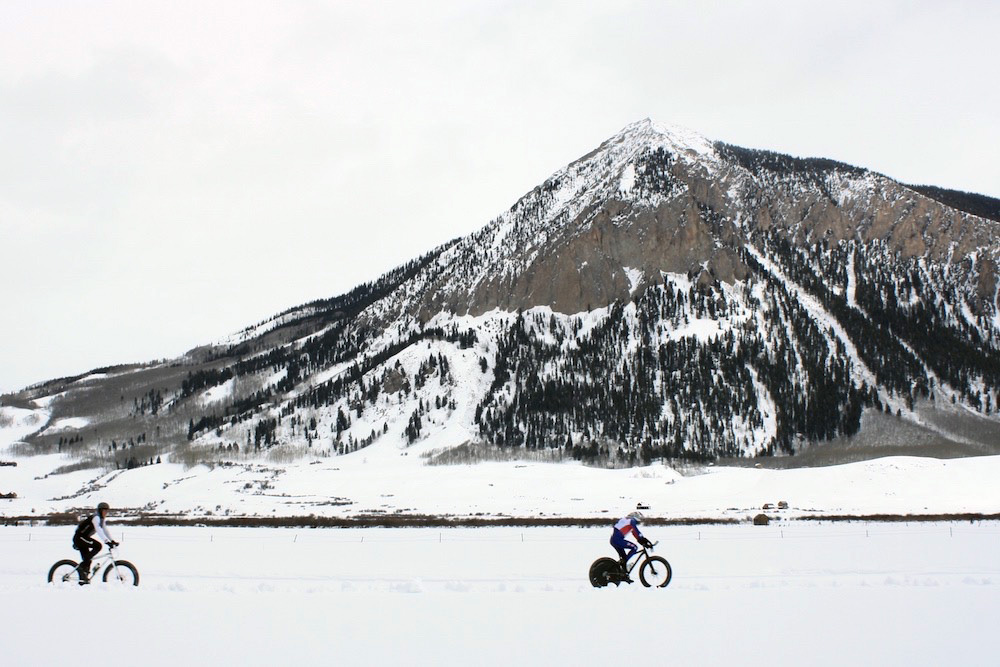The Local newsletter is your free, daily guide to life in Colorado. For locals, by locals.
Already known as a global Mecca for mountain bikers, Crested Butte is now courting off-road cycling’s newest tribe: fat bikers. On January 30, the ski town hosted the inaugural Fat Bike World Championships race, which was part of a four-day festival for the bikes.
Organizers hoped to attract 150 or so participants. When the gun went off, 260 fat bikers sped onto the racecourse, with some racers traveling from Wisconsin and Michigan.

“Right now, fat bikes are still something of an oddity,” says David Ochs, executive director of the Crested Butte Chamber of Commerce, which put on the event. “Five years from now, we think they’ll be engrained into our town’s culture.”
A quick primer: Fat bikes look like traditional mountain bikes, only with comically wide tires, which can navigate sand and snow. Largely a novelty before 2010, the bikes have exploded in popularity over the last half-decade, with major manufacturers Trek, Specialized Bicycle Components, and Diamondback all rolling out models.
The industry does not yet track fat bike sales, since they are lumped together with mountain bikes. But Gary Sjoquist, advocacy director for Quality Bicycle Products—the nation’s largest wholesale distributor of bike products—estimates that no less than 50,000 fat bikes are currently in circulation.
Despite the numbers, fat bikers often struggle to find places to actually ride, let alone race. The bikes operate best on packed snow, so fat bikers gravitate toward snowmobile trails and groomed Nordic ski centers, putting them at odds with existing user groups. The U.S. Forest Service, on the other hand, allows its local managers to determine rules for use. Often, they say no to fat bikes.
“At this point, [fat bikers] can only ride in areas where someone has fought to allow them to ride there,” Sjoquist says. “Access really depends on people’s acceptance of the bikes.”
This is also the case in Colorado, however more Nordic centers and parks are allowing fat bikers, as the group becomes a viable revenue source. Breckenridge’s Gold Run Nordic Center allows fat bikes, as does the Nordic Center in Aspen Snowmass. Devil’s Thumb Ranch in Tabernash has opened its trails to the bikes as well. At most areas, fat bikers must simply buy a day pass, and then abide by the rules.
(More: Three places in Colorado to try fat biking)
Recently, a handful of organizers started bringing fat biking into the racing business. For the past two years, Breckenridge’s Ullr Fest has featured a fat bike race. Organizers in Leadville host a race at Copper Mountain, and Glenwood Springs’ Sunlight ski resort also has a race.
Perhaps the most successful series is in Durango, where Purgatory Mountain Resort (formerly Durango Mountain Resort) is in its second year of fat bike races.
“There was some hesitation, because they have to spend to groom the trails,” says Mary Monroe Brown, executive director of Durango’s Trails 2000 advocacy group. “With [fat bikers] saying they’re willing to pay for the grooming, it has worked out.”
At Purgatory, fat bikers can buy a $15 day license or spend $100 on a season pass to access the trails.
Organizers in Crested Butte faced similar hurdles in the preparation for their three separate races. Ochs said he scrapped plans for one racecourse on National Forest Service land after managers forbade him from serving beer. Crested Butte Mountain Resort came to the rescue and allowed Ochs to use land adjacent to the ski hill.
For the world championship course, Ochs used a mix of municipal, public, and private land. Still, he had to convince private landowners that fat biking would not harm the ground.
“They were worried about damage to wildlife,” Ochs says. “I showed them it’s no different than [Nordic] skiing. Nobody really knows about fat bikes yet.”
The last frontier for the bikes, however, will be the ski resorts that dominate the mountain towns. The lion’s share of Colorado ski resorts forbid fat bikers from riding or racing on the trails. That’s because the resorts abide by the Colorado Ski Safety Act, which dictates liability for the mega businesses. The 37-year-old document does not recognize fat bikes. Ethan Mueller, president and general manager of Crested Butte Mountain Resort, says the ski industry “still needs to wrap its head around fat biking” before fat bikes become commonplace on the slopes.
Still, Crested Butte Mountain Resort took a major step toward embracing the bikes this past January when it announced it will allow fat bikers to ride on the mountain’s lower slopes before and after regular skiing hours (9 a.m. to 4 p.m.).
Mueller said the new policy is not aimed at revenue. Instead, he said, it’s a way to recognize the new user group and pay homage to the town’s love of cycling.
“We could choose to ignore fat biking,” Mueller says. “Or we could formulate a policy and let it thrive.”













